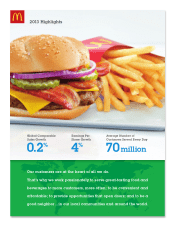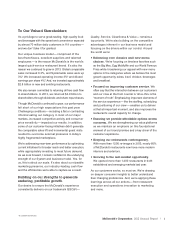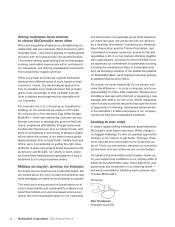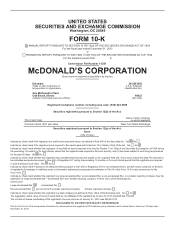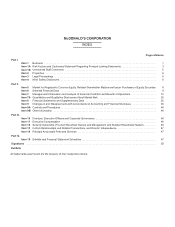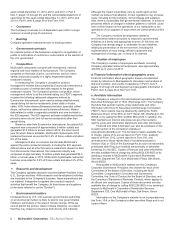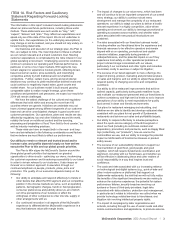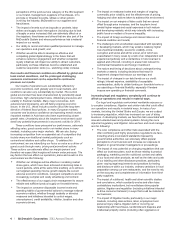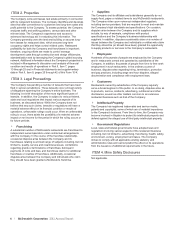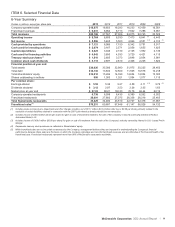McDonalds 2013 Annual Report Download - page 9
Download and view the complete annual report
Please find page 9 of the 2013 McDonalds annual report below. You can navigate through the pages in the report by either clicking on the pages listed below, or by using the keyword search tool below to find specific information within the annual report.
McDonald’s Corporation 2013 Annual Report | 1
PART I
ITEM 1. Business
McDonald’s Corporation, the registrant, together with its sub-
sidiaries, is referred to herein as the “Company.”
a. General development of business
During 2013, there were no material changes to the Company’s
corporate structure or in its method of conducting business. In
2013, the Company continued the process it began in 2005 to
realign certain subsidiaries to develop a corporate structure within
its geographic segments that better reflects the operation of the
McDonald’s worldwide business.
b. Financial information about segments
Segment data for the years ended December 31, 2013, 2012, and
2011 are included in Part II, Item 8, page 39 of this Form 10-K.
c. Narrative description of business
General
The Company franchises and operates McDonald’s restaurants in
the global restaurant industry. These restaurants serve a broad
menu (see Products) at various price points in more than 100
countries around the world.
All restaurants are operated either by the Company or by
franchisees, including conventional franchisees under franchise
arrangements, and developmental licensees and foreign affiliated
markets under license agreements.
The Company’s operations are designed to assure
consistency and high quality at every restaurant. When granting
franchises or licenses, the Company is selective and generally is
not in the practice of franchising to passive investors.
Under the conventional franchise arrangement, franchisees
provide a portion of the capital required by initially investing in the
equipment, signs, seating and décor of their restaurant
businesses, and by reinvesting in the business over time. The
Company owns the land and building or secures long-term leases
for both Company-operated and conventional franchised
restaurant sites. In certain circumstances, the Company
participates in reinvestment for conventional franchised
restaurants. A discussion regarding site selection is included in
Part I, Item 2, page 6 of this Form 10-K.
Conventional franchisees contribute to the Company’s
revenue stream through the payment of rent and royalties based
upon a percent of sales, with specified minimum rent payments,
along with initial fees received upon the opening of a new
restaurant or the granting of a new franchise term. The
conventional franchise arrangement typically lasts 20 years, and
franchising practices are generally consistent throughout the
world. Over 70% of franchised restaurants operate under
conventional franchise arrangements.
Under a developmental license arrangement, licensees
provide capital for the entire business, including the real estate
interest. While the Company has no capital invested, it receives a
royalty based on a percent of sales, as well as initial fees. The
largest of these developmental license arrangements operates
nearly 2,100 restaurants across 19 countries in Latin America and
the Caribbean.
The Company has an equity investment in a limited number of
foreign affiliated markets, referred to as "affiliates." The largest of
these affiliates is Japan, where there are nearly 3,200 restaurants.
The Company receives a royalty based on a percent of sales in
these markets and records its share of net results in Equity in
earnings of unconsolidated affiliates.
The Company and its franchisees purchase food, packaging,
equipment and other goods from numerous independent
suppliers. The Company has established and strictly enforces high
quality standards and product specifications. The Company has
quality centers around the world to ensure that its high standards
are consistently met. The quality assurance process not only
involves ongoing product reviews, but also on-site supplier visits. A
quality leadership board, composed of the Company’s technical,
safety and supply chain specialists, provides strategic global
leadership for all aspects of food quality and safety. In addition, the
Company works closely with suppliers to encourage innovation,
assure best practices and drive continuous improvement.
Leveraging scale, supply chain infrastructure and risk
management strategies, the Company also collaborates with
suppliers toward a goal of achieving competitive, predictable food
and paper costs over the long term.
Independently owned and operated distribution centers,
approved by the Company, distribute products and supplies to
McDonald’s restaurants. In addition, restaurant personnel are
trained in the proper storage, handling and preparation of
products.
McDonald’s global brand is well known. Marketing,
promotional and public relations activities are designed to promote
McDonald’s brand image and differentiate the Company from
competitors. Marketing and promotional efforts focus on value,
food taste, menu choice, nutrition, convenience and the customer
experience. The Company continuously endeavors to improve its
social responsibility and environmental practices to achieve long-
term sustainability, which benefits McDonald’s and the
communities it serves.
Products
McDonald’s restaurants offer a substantially uniform menu,
although there are geographic variations to suit local consumer
preferences and tastes. In addition, McDonald’s tests new
products on an ongoing basis.
McDonald’s menu includes hamburgers and cheeseburgers,
Big Mac, Quarter Pounder with Cheese, Filet-O-Fish, several
chicken sandwiches, Chicken McNuggets, wraps, french fries,
salads, oatmeal, shakes, McFlurry desserts, sundaes, soft serve
cones, pies, soft drinks, coffee, McCafé beverages and other
beverages. In addition, the restaurants sell a variety of other
products during limited-time promotions.
McDonald’s restaurants in the U.S. and many international
markets offer a full or limited breakfast menu. Breakfast offerings
may include Egg McMuffin, Sausage McMuffin with Egg,
McGriddles, biscuit and bagel sandwiches and hotcakes.
Intellectual property
The Company owns or is licensed to use valuable intellectual
property including trademarks, service marks, patents, copyrights,
trade secrets and other proprietary information. The Company
considers the trademarks “McDonald’s” and “The Golden Arches
Logo” to be of material importance to its business. Depending on
the jurisdiction, trademarks and service marks generally are valid
as long as they are used and/or registered. Patents, copyrights
and licenses are of varying remaining durations.
Seasonal operations
The Company does not consider its operations to be seasonal to
any material degree.
Working capital practices
Information about the Company’s working capital practices is
incorporated herein by reference to Management’s discussion and
analysis of financial condition and results of operations for the


